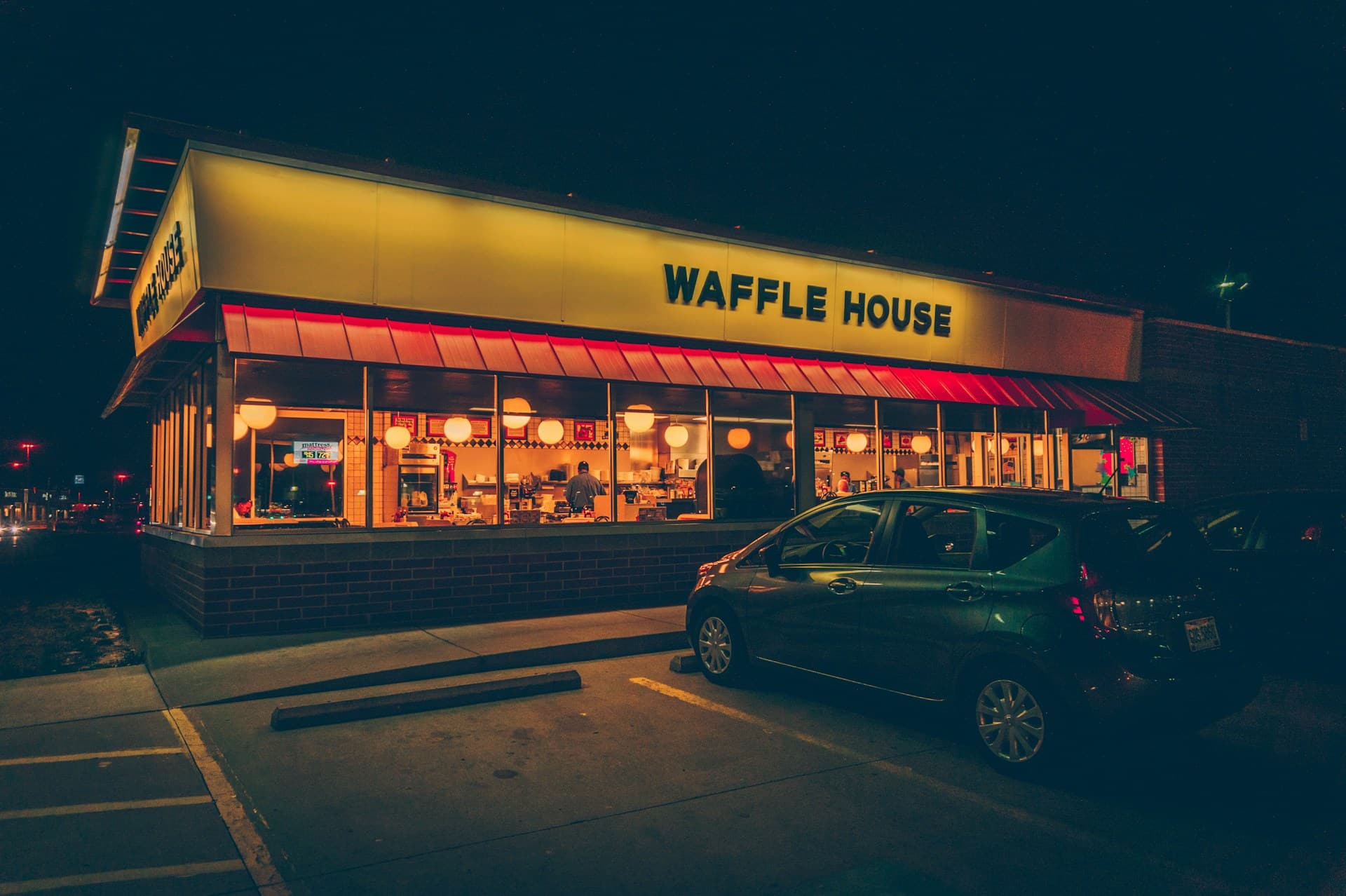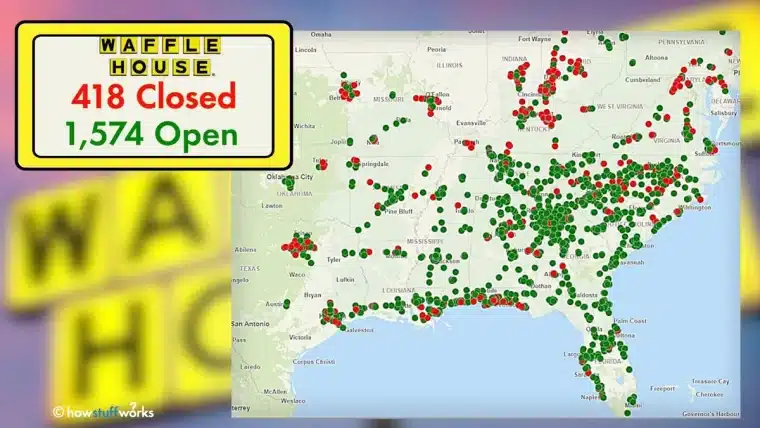In the American Southeast, the iconic yellow signs of Waffle House restaurants are more than just beacons for hungry diners seeking comfort food, no matter the hour.
During natural disasters, particularly hurricanes, these 24/7 eateries have become indicators of a storm’s severity.
A metric known as the Waffle House Index has evolved from a convenience tool for customers to a method used by both residents and federal officials to gauge the impact of storms in certain communities and areas and prioritize disaster response efforts.
The Waffle House Index relies on the operating status of its restaurants, which are known for their exceptional disaster preparedness and commitment to staying open during extreme weather events.
Also read: Elon Musk Gives Hurricane Helene Victims Free Starlink Access: Here’s How to Claim It
The index employs a simple three-color system where green indicates a restaurant is open to the public and serving its full menu. This suggests that its surroundings have not been severely impacted.
Meanwhile, yellow means that a restaurant is open but serving a limited menu. This is typically interpreted as a sign that there have been power outages or water shortages.
Finally, red means that the restaurant is closed, which means that the situation is quite bad and employees may not be able to get to the establishment while there is probably no power either.
While it might seem unconventional, the Waffle House Index has become a reliable tool to quickly assess the severity of a storm and its impact on local infrastructure.
Former Head of FEMA Created the Waffle House Index in 2004
Craig Fugate, a former administration of the Federal Emergency Management Agency (FEMA) came up with this index when he was working as the Florida emergency management director 20 years ago.
“I had been searching for something to eat while surveying the devastation left by Hurricane Charley and was only able to find a Waffle House serving a limited menu,” he claims.
He and his team noticed that Waffle House was the only place open, serving a limited menu in a certain location after Hurricane Charley hit Florida’s shores in 2004, despite the devastation that it left behind.
As a result, he started to analyze the situation of Waffle House restaurants in different areas to assess how bad the situation was.
Seven years later, he was appointed by President Barack Obama as the head of FEMA and that’s when the index became more popular. During the devastating Joplin tornado hit Missouri, Waffle House’s restaurants managed to stay open – an indication that power and water were still active.
Also read: Hurricane Helene Took Out The Most Important Mines In the World: Fallout Explained
The restaurant’s role in assessing the severity of natural disasters is not necessarily a coincidence as they have made their exceptional preparation for disastrous situations a key treat of their brand.
The management team identified that restaurants that managed to open their doors quickly right after Hurricane Katrina hit in 2005 experienced a spike in sales.
As a result, they started to make disaster management a priority and invested in portable generators, mobile command centers, and employee training to help them modify their operations and menu quickly while staying open despite the severity of the disaster that their community may be facing.
The Index is Valuable to the Southeast Region Primarily
Consumers and local leaders have embraced the Waffle House Index as an assessment tool as well. If the restaurants are closed, it is highly likely that the community may need to be evacuated (or that they should shelter in place, depending on the circumstances).
Moreover, FEMA uses the index to prioritize the deployment of their resources and assets to the most heavily hit areas – those where the restaurants have been closed.
The simplicity of the index is what has incentivized its adoption. Waffle House has more than 1,900 locations in the Southeast area of the United States. There are very few locations outside of the south, but most of the worst natural disasters in the US hit the south anyway. The company has taken advantage of the index’s popularity and is constantly sharing pictures and content that show their restaurants and their respective colors in different areas to keep the public informed.
Waffle House Index Helps Residents Prepare for Helene and Milton
Our Operations Team is working hard to get our restaurants back up and running to provide comfort and support to the first responders and communities impacted by #HurricaneMilton.
These are the #whindex unit status maps as of 2PM today. pic.twitter.com/xgZkChc1DU
— Waffle House (@WaffleHouse) October 10, 2024
The Waffle House Index has passed multiple tests as dozens of hurricanes have hit the United States since its inception. During Hurricane Helene, it proved its worth once again. Just two weeks after the storm hit North and South Carolina and Georgia, two dozen locations flashed red.
Meanwhile, other restaurants were open but operated with a limited menu. This meant that the impact of the storm was quite severe and started to produce power and water issues for locals.
In addition, as Hurricane Milton approached Florida’s Gulf Coast, the index signaled that the devastation it caused was severe. Multiple locations owned by the restaurant were closed to prepare for the storm including the ones in Tampa and Cape Coral.
Pre-emptive closures are not usual and they signal that the chain expected some severe damages resulting from the storm’s passing.
Both officials and residents took the hurricane more seriously once they saw Waffle House’s actions. Locals were encouraged to evacuate.
The Waffle House Index is a Useful Disaster Assessment Tool but Has Its Limitations
While the Waffle House Index might seem like a quirky, regional phenomenon, its impact extends beyond just predicting storm severity.
The index has become a symbol of community resilience and the role that businesses can play in disaster preparedness and recovery.
It highlights the importance of business continuity planning, as Waffle House’s ability to operate under challenging conditions not only serves the community but also helps the company maintain its operations and support its employees during difficult times. By staying open during disasters, Waffle House provides more than just food.
These restaurants often become gathering places for community members, offering a sense of normalcy and a place to connect during challenging times. The adoption of the Waffle House Index by FEMA demonstrates the value of public-private partnerships in disaster response, showing how the operations of private businesses can provide valuable data and support to government agencies during emergencies.
Also read: Elon Musk’s X Banned in Brazil: Would Europe Follow Suit?
The index has also become part of the cultural lexicon in storm-prone regions of the United States, a testament to how deeply embedded the restaurant chain is in the fabric of Southern communities.
However, there are limitations to the use of the Waffle House Index. Its effectiveness is primarily limited to areas where Waffle House has a significant presence, mainly the Southeast and mid-Atlantic regions of the United States.
Despite its use by FEMA, it is not considered an official scientific measure of a storm’s severity and should be used in conjunction with other, more formal assessment tools.
There’s also a risk that people might rely too heavily on the Waffle House Index and ignore other important warnings or evacuation orders. Some critics argue that the index might create pressure for Waffle House to stay open in potentially dangerous situations to maintain its reputation.
Despite these limitations, the Waffle House Index stands as a unique example of how a simple observation can evolve into a valuable tool for disaster assessment.

